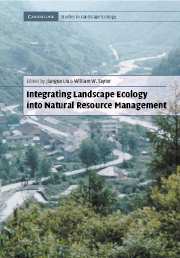Book contents
- Frontmatter
- Contents
- List of contributors
- Foreword
- Preface
- Acknowledgments
- PART I Introduction and concepts
- PART II Landscape structure and multi-scale management
- 2 Integrating landscape structure and scale into natural resource management
- 3 Focal patch landscape studies for wildlife management: Optimizing sampling effort across scales
- 4 Managing for small-patch patterns in human-dominated landscapes: Cultural factors and Corn Belt agriculture
- 5 A landscape approach to managing the biota of streams
- 6 Linking ecological and social scales for natural resource management
- PART III Landscape function and cross-boundary management
- PART IV Landscape change and adaptive management
- PART V Landscape integrity and integrated management
- PART VI Syntheses and perspectives
- Index
- Plate Section
3 - Focal patch landscape studies for wildlife management: Optimizing sampling effort across scales
Published online by Cambridge University Press: 14 January 2010
- Frontmatter
- Contents
- List of contributors
- Foreword
- Preface
- Acknowledgments
- PART I Introduction and concepts
- PART II Landscape structure and multi-scale management
- 2 Integrating landscape structure and scale into natural resource management
- 3 Focal patch landscape studies for wildlife management: Optimizing sampling effort across scales
- 4 Managing for small-patch patterns in human-dominated landscapes: Cultural factors and Corn Belt agriculture
- 5 A landscape approach to managing the biota of streams
- 6 Linking ecological and social scales for natural resource management
- PART III Landscape function and cross-boundary management
- PART IV Landscape change and adaptive management
- PART V Landscape integrity and integrated management
- PART VI Syntheses and perspectives
- Index
- Plate Section
Summary
Introduction
With ever-increasing loss and degradation of wildlife habitat, wildlife management decisions depend on a solid understanding of the influence of both patch characteristics and landscape structure on populations. Appropriately designed multi-scale ecological studies are becoming more and more important in determining how current and future land-use management decisions will affect the survival of natural populations. Effective management plans for populations and regions depend on clear and interpretable results from properly designed studies.
Historically, researchers designed studies to examine the effects of patch-scale characteristics on population dynamics. A patch is defined as a discrete area of contiguous and homogeneous habitat. Patch-based ecological studies address the relationship between the inherent characteristics of the individual patches (e.g., patch size, patch quality, patch isolation) and some ecological pattern (e.g., distribution and abundance of organisms) or process (e.g., dispersal, disturbance regimes, predation, or competition) (e.g., reviews by Andrén, 1994 and Bender et al., 1998).
Recently, researchers have begun to recognize the importance of considering the effect of the landscape context of the patch. A landscape-scale ecological study addresses one or more of (1) the effect of landscape structure on the distribution and/or abundance of organisms, (2) the effect of landscape structure on an ecological process(es) (e.g., animal movement), or (3) the effect of ecological process(es) (e.g., fire), or organisms (e.g., beavers; see Johnston, 1995), on landscape structure. Landscape structure implies spatial heterogeneity, which is described in terms of landscape composition and configuration. Landscape composition is the amount of the different landscape elements (e.g., habitat types, road cover) in the landscape. Landscape configuration describes the spatial arrangements of these elements.
- Type
- Chapter
- Information
- Publisher: Cambridge University PressPrint publication year: 2002
- 70
- Cited by



